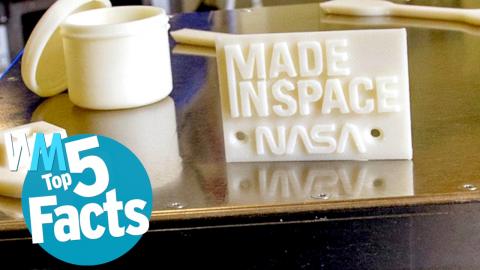Top 5 Revolutionary 3D Printing Facts

3D Printing is fascinating, amirite? It's helped NASA with projects on the ISS, it gives a new use for all that spare plastic floating around, and it may just cause a revolution yet! At the very least, it'll let us make action figures of ourselves–which is really all we care about around here.
Watch on Our YouTube Channel.
Special thanks to our user Alvaro Salvagno for submitting the idea on our Interactive Suggestion Tool at http://www.WatchMojo.comsuggest
#5: It’s Revolutionizing the Medical Field
Odds are that even the healthiest among us will utilize 3D printing on a deeply personal level at some point in the future. Uh, I was actually thinking more about the dental industr. Tens of millions of dental crowns have been produced since the technology first surfaced. Hearing aids have also become highly reliant upon 3D printing with over 60 million products printed since 2000. From jawbones, to hip replacements and just about everything in between, massive innovation has taken place in recent years. Industry analysts are saying that 3D printing is getting out of its hype stage, and is starting to deliver on its promise. Some estimate that in the next 10 years, 3D printing as an industry could be worth $550 billion dollars a year. That’s a lot of dildos– I mean, hip replacements.
#4: It’s a Big Deal How Small 3D Printing Can Be
In 2015, Guinness World Records gave ETH Zurich the world record for smallest inkjet-printed color image. Clocking in at roughly .0092 millimeters, or the width of your typical human hair, the image is of 3 microscopic clownfish in full 24-bit color. A fancy home photo printer may print at 1,200 or 2,400 dots per inch, but this guy printed at 25,000 dpi. Even though this was a flat image, this same technology is being adapted to 3D printers. The scope of this technology goes far beyond Finding nano-Nemos. Already, Lithium-ion batteries the size of a grain of sand have been produced. Some structures are being manufactured that are currently too small to even produce otherwise, such as bioscaffolds– artificial structures are planted in a patient’s body for tissue to grow on.
#3: 3D Printers Can Let You Reduce, Reuse & Recycle at Home
Those empty diet coke bottles may just come in handy. A traditional two dimensional printer needs ink in order to produce work, and for most 3D printers, plastic filament acts as ink. Happily, the word kind of has an abundance of plastic just literally floating around. So some inspired scientists and designers have developed machines that allow you to recycle junk plastic into plastic filament. A few of these systems are commercially available already. The only downside to this eco-friendly innovation is that plastics tend to get weaker the more you recycle them. Still, I’m sure a lot of people would rather turn their old milk jug into a, I don’t know, a plumbus. And hey, if material sciences keep improving, we may soon be seeing this concept applied to things like clothing!
#2: 3D Printing May Mark the Beginning of a Third Industrial Revolution
Inventions such as steam power and electricity acted as catalysts for the first and second Industrial Revolutions and ensured that life would never be quite the same again for the average citizen. Some have gone as far as to say that 3D printing may very well mark the beginning of a third industrial revolution. How so? Economies of scale resulted in earlier revolutions, with mass production lowering per unit costs. In theory, 3D printing one personalized pair of Nike sneakers should cost roughly the same amount per unit as producing a thousand Nike sneakers. Extrapolate this trend to the many different industries that may benefit from 3D printing and there may be a world where massive, standardized manufacturing plants offer the same value as highly personalized mom and pop shops. But what about all those jobs lost? How will the economy adjust? And, intellectual property, and globalization and stuff? I know, right? Should be an interesting ride.
#1: 3D Printing May Be the Key for Deep Space Travel
This should almost be a no-brainer– space travel and the newest technologies have a long history. I mean, not long long, but you know, older than me. Anyway, NASA wasted no time adapting this technology for space travel and in 2014, The International Space Station implemented its first successful earth-to-space printing job. One area that NASA apparently sees 3D printing working in space is by printing food. They’ve funded some research into it, but it seems that more research is needed. Imagine if food and tool designs could be sent from earth to space with the touch of a button? Stop imagining, they pretty much can.
So did our list add a new dimension to your understanding of 3D Printing? Are you aching for some food replicators already? For more revolutionary top 10s and pressure extruded top 5s, be sure to subscribe to WatchMojo.com
